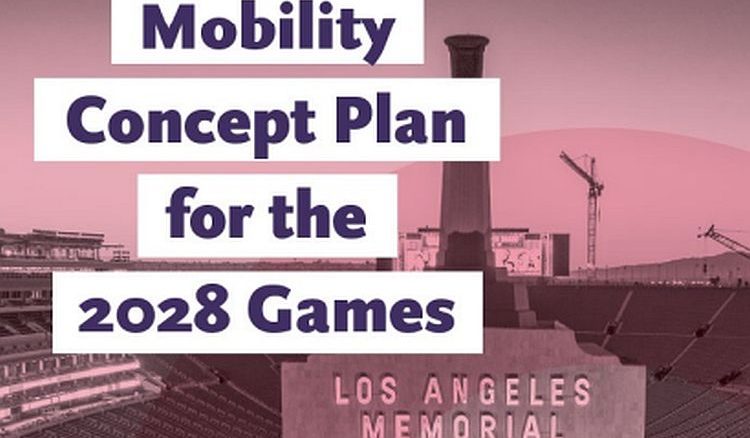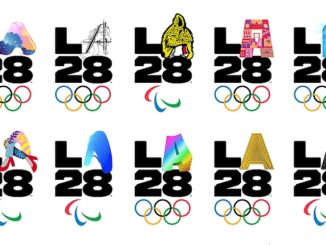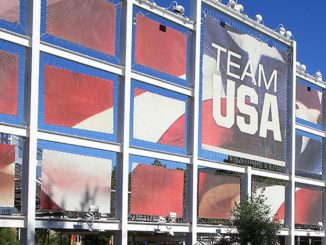
● From our sister site, TheSportsExaminer.com ●
A 35-slide presentation titled “Metro 2028 Games Mobility Concept Plan” was shared last Wednesday (18th) by Metro document watcher Numble, giving a capsule view of the public transit plan by the county-wide Los Angeles Metropolitan Transportation Authority (Metro).
The overview was just that – an overview – with a lot of questions unanswered, 47 months prior to the 2028 opening at SoFi Stadium. But there were very clear indications of what to expect:
● The objectives include the now-formalized “Car-Free, Transit-First Games” which is to mean “no spectator parking at venues.”
● A “Games Route Network” will be established, with “Priority Games Lanes where needed” with the added “NOT necessarily everywhere.”
● Coordination to minimize disruptions: road re-engineering, reductions in crossing points, signal improvements, temporary stoppage of road works, more monitoring, better enforcement and rapid vehicle removal for accidents.
The plan identifies an 80-day operations period, beginning on 13 June with Olympic operations beginning at the venues and ending on 1 September as the Paralympians return home. The “Supplemental Bus System” for spectators is scoped at 30 days, only during the competitions of the Olympic and Paralympic Games (15-30 July and 15-27 August).
The “Games Route Network” would be in operation for only 60 days, from the Olympic Village opening on 30 June, through the end of the Paralympic departure cycle on 30 August.
Metro is planning on efficiency improvements for spectator traffic, such as bus priority lanes, bus signal priorities, all-door boarding and better bus shelters.
The “Games Enhanced Transit System” will need a lot of support:
● 25 large park-and-rise sites to support spectator transfers to venues.
● 13 temporary bus malls adjacent to venues for spectator drop-off and hop-on, supported by 13 temporary bus staging areas.
● 15 temporary maintenance yards.
A total of 2,700 buses are projected to be needed for the entire project, with an added 6,000 drivers and maintenance personnel required to support them.
The presentation identified the areas with the largest expected number of ticketed spectators for the 2028 Olympic Games:
● 1.27 million: University of Southern California area, including the Memorial Coliseum.
● 1.05 million: Inglewood, including SoFi Stadium, the Kia Forum and Intuit Dome.
● 940,000: Carson area, including the Dignity Health Sports Park.
● 790,000: Pasadena area, principally the Rose Bowl
● 698,000: Long Beach area
Other downtown Los Angeles venues, such as the Crypto.com Arena and L.A. Live venues are projected to have about 677,000 total public tickets available. The presentation noted that the current average weekday Metro bus ridership is 800,000, but that the peak-day spectator trip needs during the Games could be 1.2 million.
The plan commits to zero-emission or near-zero-emission buses for 2028, but with no guarantee that that many so-equipped buses are actually available for use. School bus usage, a key in 1984 for athletes and Olympic Family members, is included as a key support element.
Special attention is being made to light-rail improvements to the A Line, which connects downtown Los Angeles to Long Beach, and the E Line, connecting downtown L.A. to Santa Monica, with stops at Exposition Park and the Coliseum.
There is a long list of things that Metro would like to do and some funding has been allocated, including $151 million in Federal funds so far. But $520 million in requests did not get awarded and $187 million in new requests have been submitted. None of this is Games-specific, but if awarded, will be used to create longer-term programs which will also help in 2028.
Observed: This latest public report shows that Metro and its planning partners have a good grip on what needs to be done, with a set of early assumptions on crowds and timing that will be refined over time.
Whether it will have the resources and will to meet these known challenges are the questions yet to be answered.
~ Rich Perelman



Be the first to comment